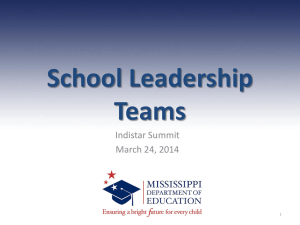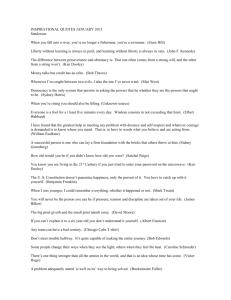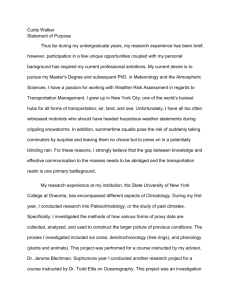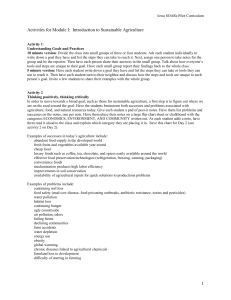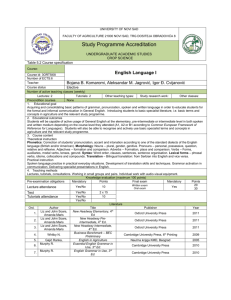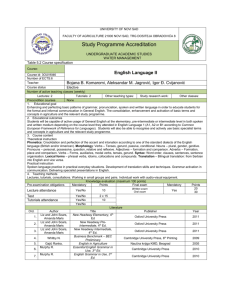PowerPoint Slides - Significant Opportunities in
advertisement
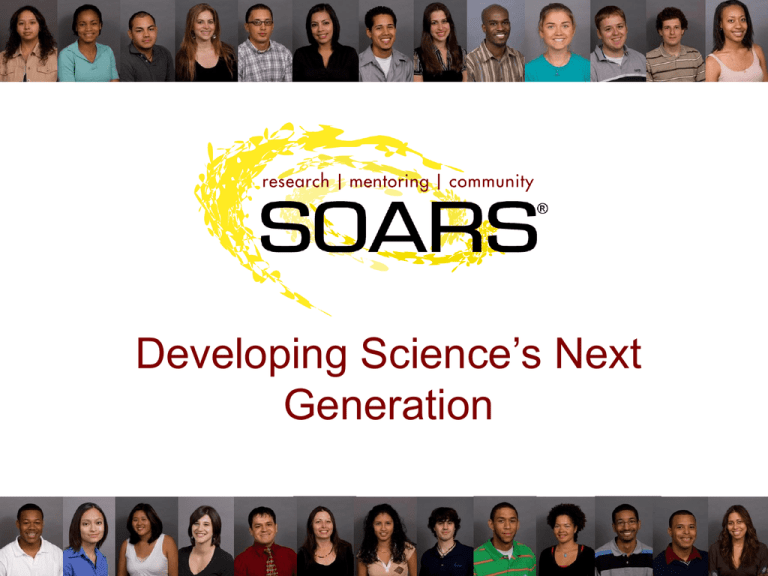
Developing Science’s Next Generation Projections for the Science Labor Pool Half of our job growth since 1945 can be attributed to our investments in science and technology. Source: National Academy of Sciences 25% of the current science and engineering workforce is more than 50 years old and will retire by the end of this decade. Source: National Science Board By 2050, the United States will be a majority-minority Nation. Source: US Census Bureau SOARS Mission Broaden participation in the geosciences by increasing the number of Black or AfricanAmerican, American Indian or Alaska Native, Hispanic or Latino, female, and firstgeneration college students who enroll and succeed in graduate school in the atmospheric and related sciences. Contribute to “a diverse, internationally competitive, and globally engaged workforce of scientists, and engineers.” - National Science Foundation Strategic Plan SOARS Values Authentic research experience Multidimensional mentoring Supportive community Professional development Comprehensive financial support Multi-year experiences SOARS Success Of the 114 Protégés who have participated in SOARS since its inception in 1996 6 earned their PhD in Science or Engineering 19 currently in PhD graduate programs 43 earned their MS in Science or Engineering 17 currently in MS graduate program 76 have earned undergraduate degrees in Science or Engineering 17 are presently undergraduates 30 protégés entered the science and engineering workforce, including at the National Oceanic and Atmospheric Administration (NOAA), Environmental Protection Agency (EPA) and National Center for Atmospheric Research (NCAR) laboratories SOARS Sponsors and Partners National Science Foundation, ATM Division of the GEO Directorate Cooperative Institute for Research in the Environmental Sciences NOAA, Climate Program Office NOAA, Oceans and Human Health Initiative CSU, Center for Multiscale Modeling of Atmospheric Processes UNAVCO, RESESS Program Hurricane Research Katrina 8/28/05 1515GMT Hurricane Katrina Sunday 8/28/05 Katrina: A storm of superlatives Most expensive disaster in U.S. history—$300 billion Deadliest U.S. storm disaster since at least 1928 Record U.S. storm surge (> 9 m) Largest weather-related U.S. mass migration since Dust Bowl (1930s) First near-total closure of U.S. city in modern times FEMA Oceans are warming, will hurricanes intensify? Number of Cat. 4-5 systems globally has nearly doubled in last 30 years Will changing risk of catastrophic systems be integrated into disaster planning? Webster et al. Researching a Changing Climate 1979 Glacial recession Arctic sea ice changes Changes in precipitation Sea-level changes Temperature records 2003 NASA-SSMI Composite Data Past and future rise in sea level 20,000 years ago 2200? ( + 5 meters) Slide from Warren Washington Modeling Climate Change to understand Observations Climate models with natural forces do not reproduce warming When increase in greenhouse gases is included, models do reproduce warming Slide from Warren Washington Solar Physics Air Chemistry MIRAGE - Megacities Impact on the Regional and Global Environment- Mexico City March 2006 Mexico City Pollution NSF/NCAR C130 Understanding the extent, persistence, and impacts of air pollution Global Societal Impacts 500-800 natural disasters per year in 90’s $600 billion lost • More than all losses from 1950-1990 • 45% lost in Asia, 30% Europe, only 10% in USA 2 billion people affected • More than 66% in Asia Half million killed FEMA • Half of these deaths due to flooding Images: NCAR Data from Rischard, J.F., 2002 Diversity of Research at NCAR Meteorologists Engineers Chemists Environmental Scientists Physicists Computer Scientists Social Scientists 1. Research During the 10 week SOARS/RESESS experience at NCAR, UNAVCO, NOAA Labs protégés: Conduct original research Prepare a scientific paper Deliver a 30 minute oral presentation at closing colloquium 2. Mentoring PEER MENTOR RESEARCH MENTOR SOARS PROTÉGÉ COMMUNICATIONS MENTOR COMMUNITY MENTOR 3. Community Peer mentoring Workshops and seminars Shared living/transportation Conferences!! Help with your poster Conference travel funding Get to know graduate schools Professional development What else can you get from summer research with SOARS? Writing & Communication Skills In depth Mentoring Networking Perks Housing, stipend (always) Conference travel Undergraduate and graduate school support Plate tectonics and seismology in the Koryak Region: A perspective on the 20 April 2006 Kahilino-Tilichiki, Russia Earthquake Cynthia Boshell Mathematics and Physics Humboldt State University, CA Return Levels Under a Changing Climate Marcus Walter Meteorology The Pennsylvania State University Stabilization Scenarios: Sensitivity of Resulting Emissions Pathways to Experimental Carbon Turnover Rates for Ocean Circulation, Vegetation Growth and Soil Respiration Preliminary Results: A2 Scenario - 800 ppmv by 2100 VegetationSoil Sink Ocean Sink ZiZi Searles Geology San Francisco State University The Intern who became a Hurricane Hunter Shirley Murillo: in SOARS for 3 years Today: Meteorologist and ‘hurricane hunter’ with the Hurricane Research Division at (NOAA) in Miami, FL. In special storm planes, she flies straight into the earth's deadliest storms to collect life-saving information “I study winds inside of hurricanes, which can reach speeds up 150 mph! My job is to collect and analyze wind data from satellites and aircraft that monitor hurricanes.” “Using a computer, I generate maps of wind patterns in the storm, and pass them on to forecasters who warn residents of brewing hurricanes.” How to apply Application requires: Transcripts 2 letters of recommendation, 3 essay questions Deadline Feb 1 Websites: www.soars.ucar.edu http://resess.unavco.org/ Thank you ! SOARS Program soars@ucar.edu 303-497-8622 www.soars.ucar.edu
